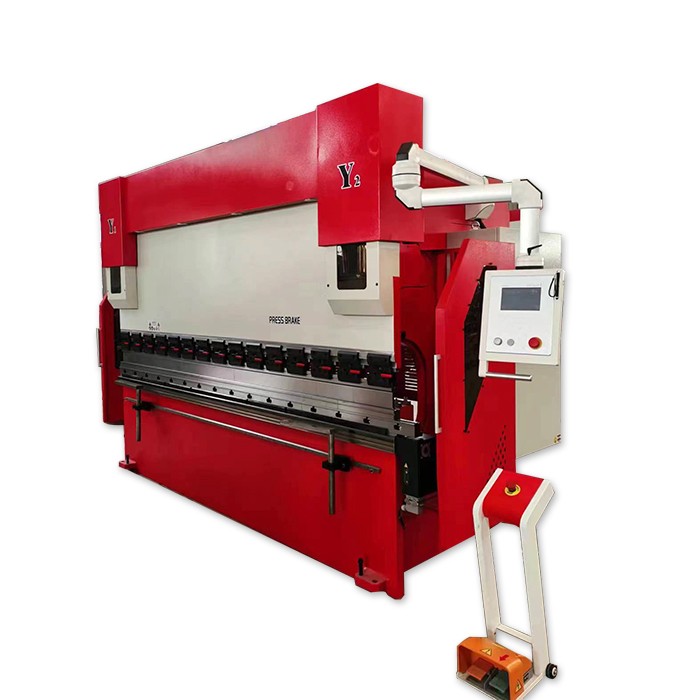

We are a professional plate bending machine manufacturer with over 10 years of industry experience. Today, we would like to introduce the debugging and application of collision warning devices for plate bending machine:

As an important piece of equipment for metal sheet processing, the safety of a plate bending machine directly affects the health and safety of operators and the production efficiency of enterprises. Collision warning devices are a key safety feature of modern bending machines, effectively preventing accidental collisions between molds, workpieces, or equipment components. This article will systematically introduce the debugging process and practical application points of this device.
1. System Composition and Operating Principle
Collision warning systems typically consist of three components: a sensor system, a control unit, and an alarm module. The sensors continuously monitor the relative position between the upper and lower dies of the bending machine. When abnormal proximity is detected, the control unit immediately analyzes the data and assesses the collision risk. If a potential hazard is identified, the alarm module alerts the operator via audible and visual signals. Some advanced systems can also automatically pause equipment operation.
The core of this system lies in precise distance monitoring and rapid response mechanisms. Unlike traditional mechanical limit switches, modern warning systems utilize non-contact measurement technology, enabling risk identification at a sufficiently early stage before a collision occurs, thereby providing operators with ample reaction time.
2. Debugging Process
Installation inspection is the first step in debugging. Confirm that the sensor is correctly installed and securely fixed in place, and that all connections are secure and reliable. The sensor probe should be kept clean to avoid oil stains or metal shavings affecting detection accuracy. At the same time, check that the device power supply is stable and that the grounding is good, as these basic conditions directly affect the subsequent debugging results.
Parameter settings must be adjusted according to the specific bending machine model and working conditions. Key parameters include safety distance thresholds and response sensitivity. The safety distance should be set by comprehensively considering factors such as die size, material thickness, and bending speed, typically with an appropriate margin to ensure safety. Sensitivity settings must balance false alarm rates with the risk of missed alarms; too high a setting may cause frequent false alarms, while too low a setting may fail to provide timely warnings.
Functional testing is divided into two stages: No-load testing and simulated testing. During no-load testing, manually move the slide to observe whether the device responds normally. Simulated testing involves using specialized tools to artificially create a near-contact state to verify the accuracy of the alarm trigger timing. Testing should cover the entire travel range of the equipment, with particular attention to the reliability of detection near the upper and lower dead points.
Interlocking debugging ensures that the warning system and the bending machine control system work in coordination. Test whether the alarm signal is correctly transmitted to the host and whether the emergency stop function is effective. At the same time, check whether the device interferes with the normal operation of the equipment and whether the timing of each action is correctly connected.
3. Application Guidelines
In actual production environments, routine calibration must not be overlooked. It is recommended to conduct a simple functional check before each shift begins, and have a comprehensive inspection performed by professionals on a monthly basis. In the event of environmental changes such as significant temperature fluctuations or after equipment relocation, the sensors must be recalibrated.
Regarding operational procedures, staff training is of utmost importance. Operators should understand the device's operating principles, know how to distinguish between genuine and false alarm signals, and master basic methods for addressing faults. When an alarm is triggered, current operations must be stopped immediately, the cause identified, and potential hazards eliminated before resuming work.
Maintenance and upkeep include regularly cleaning the sensor surface, inspecting for signs of aging in the wiring, and promptly replacing worn-out components. Additionally, monitor the device's operational status; if abnormal phenomena such as delayed alarms or frequent false alarms are detected, the device should be immediately shut down and technical personnel contacted for repairs.
4. Troubleshooting Common Issues
Sensor malfunctions are often caused by contamination or positional shifts. Cleaning and recalibration typically resolve the issue. For intermittent faults, inspect the wiring connections and power supply stability. False alarms are commonly caused by environmental electromagnetic interference or improper parameter settings. Adjusting the installation location or resetting the sensitivity can improve performance.
System response delays may result from processor overload or signal transmission blockages. In such cases, hardware upgrades or program optimization may be necessary. When the device frequently experiences abnormalities that cannot be resolved independently, contact the manufacturer's technical support promptly to avoid unauthorized disassembly or modification.
The effective application of collision warning devices for bending machines requires not only correct installation and debugging, but also standardized daily use and maintenance. Through scientific settings and strict adherence to operating procedures, these devices can significantly reduce the risk of equipment collisions and ensure production safety. With technological advances, future warning systems will become more intelligent and integrated, but their core purpose will always be to provide reliable safety protection for metalworking operations.
If you are interested in plate bending machine, please contact us.
 Address:Room 1202, Detaitang Building, No. 118 Huaguang Road, Zhangdian District, Zibo, Shandong
Address:Room 1202, Detaitang Building, No. 118 Huaguang Road, Zhangdian District, Zibo, Shandong WhatsApp:+8615653328535
WhatsApp:+8615653328535 Wechat: +8615965331535
Wechat: +8615965331535  E-mail:zs@sdsmachinery.com
E-mail:zs@sdsmachinery.com